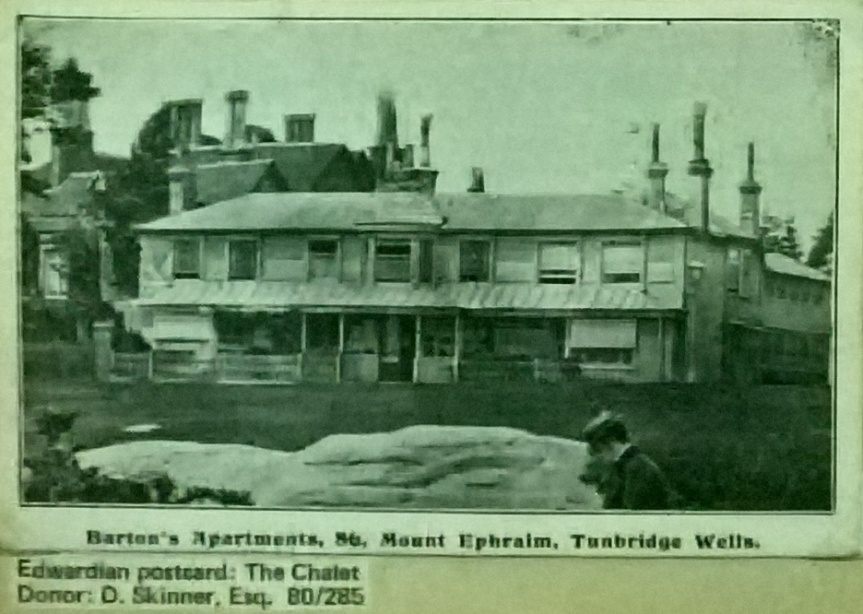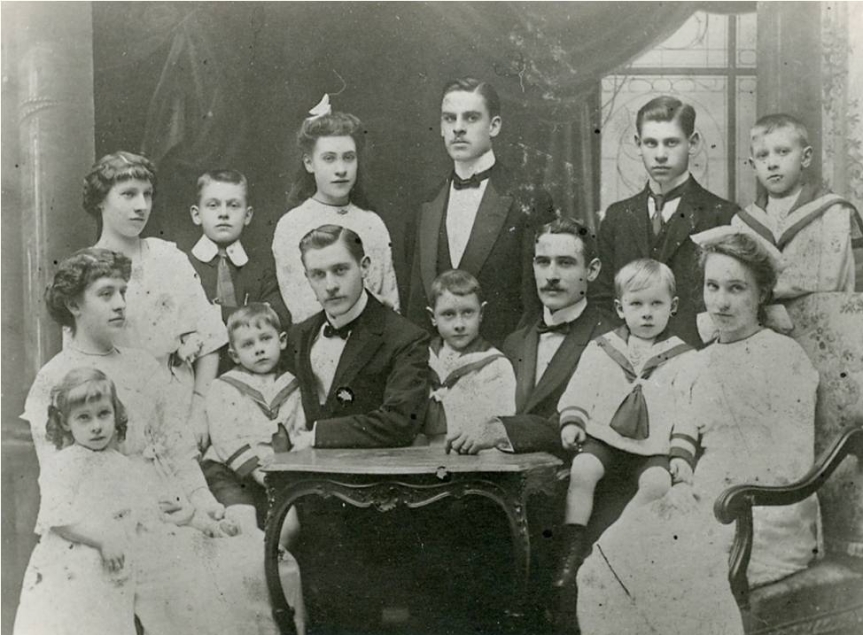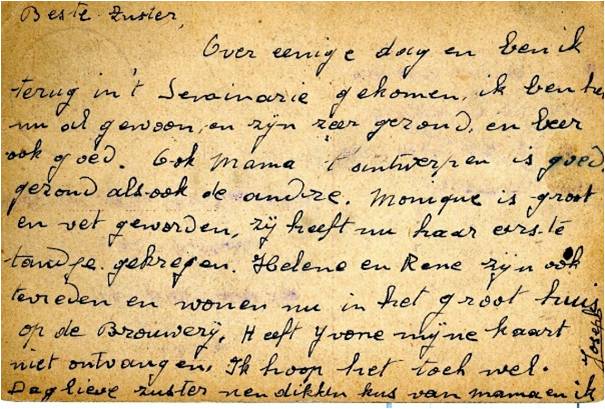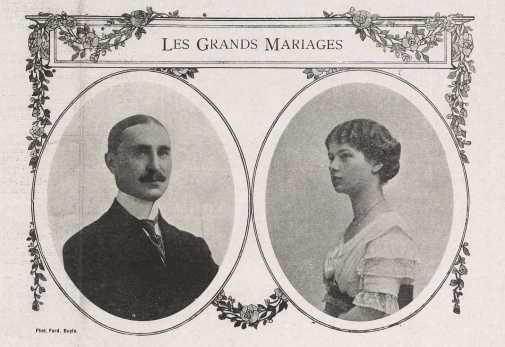Het is doodjammer dat men niet meer kan beschikken over de volledige briefwisseling van en naar de familie Boeynaems die tijdens WO 1 naar Engeland was gevlucht. Vooral de brieven verzonden vanuit de vluchtadressen in Engeland hadden waardevol materiaal kunnen bevatten. Maar die briefwisseling is tot op heden niet teruggevonden. Enkel een zestal brieven en een tiental postkaarten naar Engeland zijn bewaard gebleven. Toch genoeg om een puzzel te leggen. Het werd een puzzel met veel ontbrekende stukjes. Geen volledig verhaal, eerder een opsomming van gebeurtenissen, locaties….
Bij het uitbreken van de 1ste Wereldoorlog telde het gezin van Florent Boeynaems en zijn echtgenote Marie Coosemans 14 kinderen. Zij woonden in de Prinsstraat nr. 5 te Antwerpen. Vader Florent Boeynaems oefende er het ambt uit van notaris.
|
Florent Boeynaems X Marie Coosemans
(1860-1915) (1866-1946)
|
| Hun kinderen |
Leeftijd in 1914 |
| Ferdinand (Fernand) 1889-1918 |
25j |
| Paul 1891-1958 |
23j |
| Hélène 1892-1944 |
22j |
| Hubert 1893-1961 |
21j |
| Marthe 1895-1940 |
19j |
| Jean (Jan) 1897-1969 |
17j |
| Suzanne 1898-1982 |
16j |
| Yvonne 1900-1986 |
14j |
| Florent (Flor) 1901-1980 |
13j |
| Pierre (Piet) 1903-1986 |
11j |
| Joseph (Jos) 1906-1984 |
8j |
| Marie Louise (Mimi) 1908-2004 |
6j |
| Jacques (Jaak) 1909-1995 |
5j |
| Ludovic 1910-1996 |
4j |
Moeder Marie Coosemans was de halfzuster van Florent Coosemans, de voorzitter van de Albert Club in Tunbridge Wells tijdens WO1. Florent Coosemans was gehuwd met Louise Martin. Zijn vader Ferdinand Coosemans trad tweemaal in het huwelijk. Zijn eerste echtgenote overleed kort na de geboorte van Marie Coosemans in 1866.
|
Ferdinand Coosemans (1828-1926) 1° X Maria Van Welde (1829-1866)
|
| Hun kinderen |
Gehuwd met |
| Constant Coosemans 1861-1923 |
Marie Van Goethem |
| Marie Coosemans 1866-1946 |
Florent Boeynaems |
| Ferdinand Coosemans (1828-1926) 2° X Anne Cornélie Van de Wiel (1836-1906) |
| Hun kinderen |
Gehuwd met |
| Caroline Coosemans 1871-1959 |
Charles Cnoops |
| Florent Coosemans 1872-1947 |
Louise Martin |
| Hortense Coosemans 1873-1935 |
Felix Goris |
| Berthe Coosemans 1875-1950 |
Alfons Steyaert |
In 1913 waren het nog hoogdagen bij de familie Boeynaems-Coosemans. Twee zilveren jubilea. Vader Florent Boeynaems vierde zijn 25- jarig ambtsjubileum als notaris. En het echtpaar was in november ook nog 25 jaar gehuwd. Dit leek het uitgelezen moment om de kinderen te verzamelen voor een groepsfoto. Een unieke foto want zo zagen de kinderen Boeynaems er uit vlak voor hun vertrek naar Engeland.

Als op 7 oktober 1914 de vijandelijke Duitse troepen al aan de rand van de stad Antwerpen stonden werd de Burgerwacht ontbonden. Paul Boeynaems was sedert 1912 in dienst bij de Burgerwacht als kanonnier. Bevangen door angst en verward door vreselijke verhalen sloeg de bevolking massaal en paniekerig op de vlucht naar Nederland. Zo verging het ook met de familie Boeynaems.
De kinderen Boeynaems vertrokken zonder hun ouders. Volgens een verhaal van Marie-Louise Boeynaems, opgetekend in 1999, verzamelden de kinderen zich achteraan in het ouderlijk huis in de Prinsstraat en moesten één na één afscheid nemen van hun geliefde vader en moeder. Via Nederland reisden ze door naar Engeland. Ook sommige van hun ooms en tantes vluchtten naar Engeland: oom Florent en tante Louise (Coosemans-Martin), oom Charles en tante Caroline (Cnoops-Coosemans) en oom Gustave en tante Marie (Simons-Boeynaems / Marie was de zus van vader Florent Boeynaems). Het is niet duidelijk of nog andere familieleden volgden en of iedereen samen vertrok. Zelfs de exacte datum van vertrek blijft onbekend.
1914 De kinderen Boeynaems waren alleszins op een vast adres,in Nederland of in Engeland, vóór 13 oktober 1914. Andere familieleden waaronder misschien ook moeder Marie Coosemans verlieten de stad pas toen de eerste bom viel op de Blindestraat in Antwerpen. Ze hielden halt in Standdaarbuiten en Oudenbosch in Nederland. In een brief van 13 oktober 1914 werden de kinderen ingelicht over de verwarde toestand in Nederland. Iedereen was daar op zoek naar familieleden. Ook de familie van Meerbeeck uit Wilrijk werd door andere familieleden opgezocht. Hélène Boeynaems was verloofd en zou in 1915 huwen met René van Meerbeeck, zoon van de bedoelde familie. Ingegeven door angst en op aanraden van de plaatselijke autoriteiten werd er aan Ferdinand en Paul gevraagd om niet terug te keren naar België. Maar nog vóór het einde van februari 1915 waren de ouders en Ferdinand al opnieuw thuis in Antwerpen. Zoon Ferdinand keerde uiteindelijk terug naar huis om zijn vader Florent Boeynaems te helpen die gezondheidsproblemen had.
(cfr. Brieven van 13 oktober 1914 en 2 maart 1915)
1915 Om censuur en verlies van post te vermijden werden de brieven vanuit en naar bezet België verzonden via tussenpersonen in Nederland. In de eerste maanden van de oorlog had de familie Boeynaems twee tussenpersonen Dhr. Reinemund en Dhr. Mattheezen die in Bergen op Zoom verbleven. Paul en Jean Boeynaems verlieten Engeland en reisden door naar Frankrijk om zich daar aan te melden als oorlogsvrijwilliger bij het Belgisch Leger. Paul ondertekende op 19 februari 1915 een verbintenis in Rouen (F) en Jean deed hetzelfde in Parigné-l’Evêque (F) op 29 april 1915. Beide broers hielden contact met de rest van de familie in Engeland via hun zuster Marthe. Zij werd het aanspreekpunt van de familie in Engeland. Met het adres op een kaartje van Paul Boeynaems aan zijn zus Marthe wordt het duidelijk dat Marthe en waarschijnlijk ook de andere kinderen op 14 maart 1915 in London Wimbledon, Alwine Mansion 22 verbleven. Was dit het eerste vluchtadres in Engeland? Ondertussen was de gezondheidstoestand van vader Florent Boeynaems zodanig verergerd dat men hem de laatste sacramenten had toegediend. Hélène Boeynaems en haar broer Hubert moesten dringend terugkeren naar huis om hulp te bieden. De brief om hulp dateerde van 26 maart 1915 en was via een tussenpersoon, Dhr Van Nieuwenhuize, geadresseerd aan Hélène Boeynaems in Tunbridge Wells, York Road 44. De reis werd geregeld in samenwerking met Dhr Léon Van Nieuwenhuize die in London Harrow, College Road nr. 8. verbleef. De broer van Alice Van Nieuwenhuize moest ook terugkeren naar België. Indien men het wou mocht ook één van de kleine kinderen Boeynaems meereizen. De reis ging langs Vlissingen.
 |
 |
In Antwerpen deden de broers Ferdinand en Hubert er alles aan om het notariaat van hun vader te redden. Ferdinand was kandidaat-notaris en was een welkome hulp in het notariaat. Broer Hubert was voornamelijk behulpzaam in de administratie. Wat gepland was ging door en Hélène huwde in de zomer met René van Meerbeeck. Paul Boeynaems begon in juli 1915 een officiersopleiding in Bayeux. Als ex-burgerwachter werd hij ingezet als instructeur. Jean Boeynaems vertrok naar het Front. De broers bleven met elkaar in contact en zagen elkaar tijdens een militaire verlofperiode in De Panne. De kinderen Boeynaems verhuisden van de York Road naar Tunbridge Wells, Capilano, Upper Grosvernor Road 154 B. Ze waren er alleszins in augustus 1915. Iets later in het jaar verhuisden ze naar Tunbridge Wells, Beltring Road 19. Hier waren ze zeker op 26 november 1915. Eind augustus 1915 ontving Marthe Boeynaems een postkaart van haar zus Hélène waarin ze het relaas deed over haar huwelijk met René van Meerbeeck. De briefkaart werd verstuurd via een tussenpersoon in Moensel bij Eindhoven in Nederland.
Ludovic,/ Marie-Louise / Jacques |
De drie jongste kinderen Boeynaems poseerden in de lente/zomer in St. John’s Recreation Ground in de onmiddellijke omgeving van Beltring Road 19 in Tunbridge Wells
Jacques en Ludovic droegen hun matrozen kraagje zoals op de foto uit 1913. |
Het oorlogsjaar 1915 eindigde in mineur. Vader Florent Boeynaems en de kinderen in Engeland bleven voor altijd gescheiden. Florent Boeynaems overleed op de vooravond van Kerstmis 1915. Hij was amper 55 jaar.
(cfr. Brieven van 2 maart 1915 en 26 maart 1915, postkaarten van 14 maart 1915, 20 april 1915, 1 augustus 1915, 16 augustus 1915, 26 november 1915 en 17 december 1915)
1916 Paul Boeynaems vroeg zijn overplaatsing naar het Front en kwam in februari 1916 terecht in hetzelfde regiment van zijn broer Jean. In een brief van 6 september 1916 lezen we dat moeder Marie Coosemans en haar zoon Joseph Boeynaems in Kerkom (Boutersem) waren om tante Regina Van Welde te bezoeken. Regina Van Welde was de zus van Maria Van Welde, de overleden moeder van Marie Coosemans. Ze verbleven er enkele dagen. Joseph Boeynaems was dus niet in Engeland. Ofwel was hij altijd al thuis gebleven ofwel was hij in 1915 meegekomen naar Antwerpen met Hélène en Hubert. Na het overlijden van hun vader kregen de kinderen in Engeland extra morele steun van hun oom Gustave en tante Marie (Simons- Boeynaems) . In Tunbridge Wells brachten de Belgische vluchtelingen geregeld hulde aan de leden van hun opvangcomité. Als blijk van dank voor de opvang, het onthaal en de onverdroten inzet werden in juli 1916 twee bijzondere leden van het Mayor’s Belgian Refugees Committee gehuldigd: de gezusters Amelia en Louisa Scott. Zij ontvingen een album volledig versierd met allerlei tekeningen, schilderijtjes, teksten, gedichten, muziekstukken en handtekeningen en namen van de Belgische vluchtelingen. In dit album “The Misses Scott Album” werden teksten geschreven door Florent Coosemans en zijn echtgenote Louise Martin en ook naamkaartjes gekleefd met de namen van de kinderen Boeynaems Marthe, Suzanne, Florent, Yvonne, Pierre, Jacques, Marie-Louise en Ludovic.
In een brief aan zijn zus Marthe probeerde Ferdinand Boeynaems duidelijk te maken dat het leven in bezet België er veel slechter aan toe was dan in Engeland. Er was veel ontbering en schaarste. Noodgedwongen door de omstandigheden en voor hun bestwil werden de kinderen door Ferdinand aangemaand om in Engeland te blijven. Desnoods mochten ze verhuizen naar een andere locatie en hierover eventueel raad vragen aan de rest van de familie die ter plaatse was of zelfs ook aan hun broer Paul. Marthe was tijdelijk tewerkgesteld als vrijwilliger in het West Hall Hospital in Tunbridge Wells. Het was één van Voluntary Aid Detachment hospitalen van het Rode Kruis in Tunbridge Wells. Marthe was geen verpleegster maar het hospitaal kon alle hulp gebruiken; in de hospitalen lagen ook Belgische slachtoffers. Ze bleef er waarschijnlijk een tijdlang overnachten want haar broer Paul zond in september 1916 een kaartje op dat adres: Tunbridge Wells, West Hall Hospital, Chilston Road.
(cfr. Postkaarten van 16 februari 1916, 2 maart 1916, 7 september1916 en een brief van 8 september 1916)
1917 De kinderen verlieten Tunbridge Wells eind 1916 of begin 1917. Ze verhuisden naar London en vestigden zich eerst in South Kensington: London South Kensington, Onslow Gardens 18 en London South Kensington, Gledhow Gardens, 2. Nog in datzelfde jaar verhuisden ze naar London, Russell Square 21. Dit werd hun laatste adres in Engeland. Ze trokken in boven de kantoren van de krant “De Stem uit België” uitgegeven door kanunnik Floris Prims, goed gekend in de familie Boeynaems. Suzanne en wellicht ook Marthe en Yvonne Boeynaems werden er tewerkgesteld in de administratie. In januari of februari 1917 waren Jean en Paul Boeynaems met verlof in Engeland en lieten zich samen met hun broers en zussen fotograferen voor een familiefoto. De foto werd genomen door Sketches – Oxford Street, 72 London.

–Yvonne-Florent-Suzanne-Paul-
–Jean-Marthe-Pierre-Marie Louise-
–Jacques-Ludovic
In mei 1917 kregen Hélène Boeynaems en René van Meerbeeck hun eerste kindje, Monique van Meerbeeck. In datzelfde jaar betreurden de kinderen Boeynaems het overlijden van hun grootoom en groottante Jean Hagenaers en zijn echtgenote Louise Boeynaems, hun groottante Régina Van Welde en hun tantes Marguerite Boeynaems en Marie Boeynaems. Eind 1917 was Marie-Louise Boeynaems ziek geworden op school in St Leonards-on-Sea en kwam een week rusten bij haar zussen in Londen. Zoon Florent die met schoolverlof was in Londen vertelde in een lange brief aan zijn broer Pierre al het nieuws uit de Russel Square 21 en ook zijn belevenissen in de nieuwe school in Norwood.
(cfr. Postkaart van 25 maart 1917, brief van 10 december 1917)
1918 In januari ontving Marthe Boeynaems nieuws uit Antwerpen van haar zus Hélène en haar broer Joseph. De postkaarten werden verzonden via een tussenpersoon uit Nederland:
Dhr. Van Herck, een steenfabrikant in Sluiskil Terneuzen. Om de Duitse bezetter te misleiden en de naam van de uiteindelijke bestemmeling toch te verduidelijken werd in de adressering de voornaam van Marthe gekoppeld aan de familienaam van de tussenpersoon.
Hubert Boeynaems stuurde een postkaart naar Dhr. De Roeck in Engeland om nieuws te ontvangen omtrent het overlijden van Marie Boeynaems, echtgenote van Gustave Simons. Ook deze kaart ging via Terneuzen.
Hélène van Meerbeeck-Boeynaems en haar dochtertje Monique waren tijdens het Kerstverlof op bezoek in de Prinsstraat.
 |
|
Hubert – Ferdinand
Hélène – moeder Marie Coosemans – Monique – Joseph
Achteraan op een kastje, tussen Joseph en Ferdinand, prijkt de foto van Paul Boeynaems in militair tenue
|
Jean Boeynaems raakte gekwetst en werd op 1 oktober afgevoerd naar een hospitaal in Le Havre (F). Paul Boeynaems kreeg op 8 november een vermelding in de dagorde van zijn regiment voor zijn vastberaden houding bij de bevrijding van het kanaal in de streek van Ertvelde tijdens het eindoffensief. Yvonne Boeynaems keerde terug naar Antwerpen op het einde van 1918.
Uitgerekend op de dag dat de wapens zwegen overleed Ferdinand Boeynaems. Hij stierf ten gevolge van de Spaanse griep. Vreugde sloeg al vlug om in verdriet. Niet lang voordien stond hij nog lachend op een familiefoto thuis in de Prinsstraat..
1919 De brieven van 9 en 10 januari waren de enige brieven vanuit Engeland naar het thuisfront die werden teruggevonden. Hierin lezen we dat Suzanne Boeynaems nog in London was. Ze schreef aan haar zus Yvonne dat veel vluchtelingen al vertrokken waren. Ze kondigde ook het nakende vertrek aan van de familie René Dieltiens, de familie Denijn en ook van Mevr. Brusselmans. Het is niet geweten wanneer al de kinderen Boeynaems volgden. Na het Kerstverlof 1918/1919 vervoegden Pierre en Florent Boeynaems alleszins opnieuw de school in Upper Norwood. Jean Boeynaems werd op 6 augustus 1919 met onbepaald verlof geplaatst en Paul Boeynaems op 15 augustus 1919. Niet iedereen keerde terug naar Antwerpen. Marthe Boeynaems had zich intussen verloofd met een arts uit Kortrijk, Karel Depla. Ze huwden in Londen in 1920 en kregen zes kinderen. Maar het noodlot sloeg opnieuw toe. De tweede wereldoorlog werd haar fataal. Ze overleed tijdens een bombardement op Londen in 1940. Haar kinderen en kleinkinderen bleven in Engeland.
(cfr.Brieven van 9 en 10 januari 1919)
Het onderwijs
Zodra het mogelijk was werden de kinderen ondergebracht in kostscholen. De jongens Florent, Pierre, Jacques en Ludovic Boeynaems volgden eerst onderwijs in Stroud in het graafschap Gloucestershire. Florent verliet de school in Stroud en verhuisde naar het St. Mary’s College in Upper Norwood in zuidoost Londen. Later gingen Pierre, Jacques en Ludovic naar het St Joseph College in Malvern Wells in het graafschap Worcestershire. In 1919 waren Pierre en Florent Boeynaems in het St.Mary’s College in Upper Norwood. Ludovic verbleef ook enige tijd in het St Paul’s Convent in Brighton. Marie-Louise vervoegde de Convent school in St Leonards-on-Sea bij Hastings in het graafschap Sussex.
Wie is wie
In heel wat brieven en postkaarten werden namen vermeld die tot op heden onbekend zijn gebleven. Misschien kunnen sommige lezers en lezeressen meer verduidelijking brengen bij sommige namen. En horen die namen wellicht ook thuis in een ander verhaal. Reacties zijn altijd welkom.
* Bij de vlucht uit België in 1914: Nuchelmans, Sluyts, Scrivener ?
* In een brief van 26 maart 1915: Leo of Léon Van Nieuwenhuize, Alice Van Nieuwenhuize en haar broer ?
* Op een postkaart van november 1915 van Jean Boeynaems: René De Jongh en Etienne ?
* Op een postkaart van 16 februari 1916 van Jean Boeynaems: Adolphe, Emmanuel, Arnold Van Kerkhoven, Lahaye, Dupuis?
* Op een postkaart van 25 maart 1917 van Jean Boeynaems: Mej Lombart (heeft pakje naar hem gestuurd) ?
* In een brief van 10 december 1917 van zoon Florent Boeynaems:
– Mevr Maria Van Bavel (was tewerkgesteld bij “De Stem uit België”) ?
– Mevr Josephine (was tewerkgesteld bij “De Stem uit België”) ?
– Bouveroux, Willemsen Maes, leraars ?
– Arsène, Piesen, Cornelius, medeleerlingen van Florent en Pierre Boeynaems ?
– Dhr Fernand Robert ?
Cyriel Boeynaems 13 juni 2017
Ik ben zo dankbaar voor Cyriel voor deze bewegende en persoonlijke rekening van de ervaringen van zijn familie. Als u kunt helpen bij een van zijn vragen, of kan toevoegen aan het verhaal van zijn familie, neem dan contact met hem op via de contactpagina van deze blog. Dank je. Alison MacKenzie
 The piece was inspired by the Tunbridge ware exhibits in the Museum – I had previously discovered a link between Tunbridge ware maker Thomas Barton and the town’s refugees from Belgium.
The piece was inspired by the Tunbridge ware exhibits in the Museum – I had previously discovered a link between Tunbridge ware maker Thomas Barton and the town’s refugees from Belgium.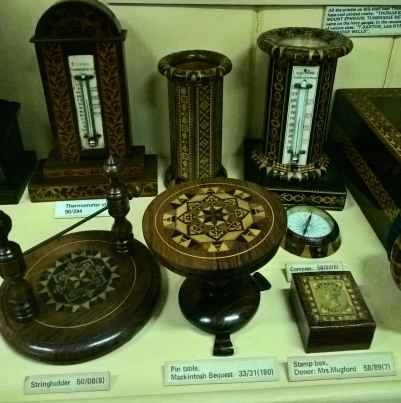


 Kate and Frank GIELGUD’s third child, Arthur John GIELGUD, the future Sir John GIELGUD, actor and director, was born on 14 April 1904, followed by sister Frances Eleanor in 1907. I wonder whether they spent any other holidays in Tunbridge Wells?
Kate and Frank GIELGUD’s third child, Arthur John GIELGUD, the future Sir John GIELGUD, actor and director, was born on 14 April 1904, followed by sister Frances Eleanor in 1907. I wonder whether they spent any other holidays in Tunbridge Wells?
